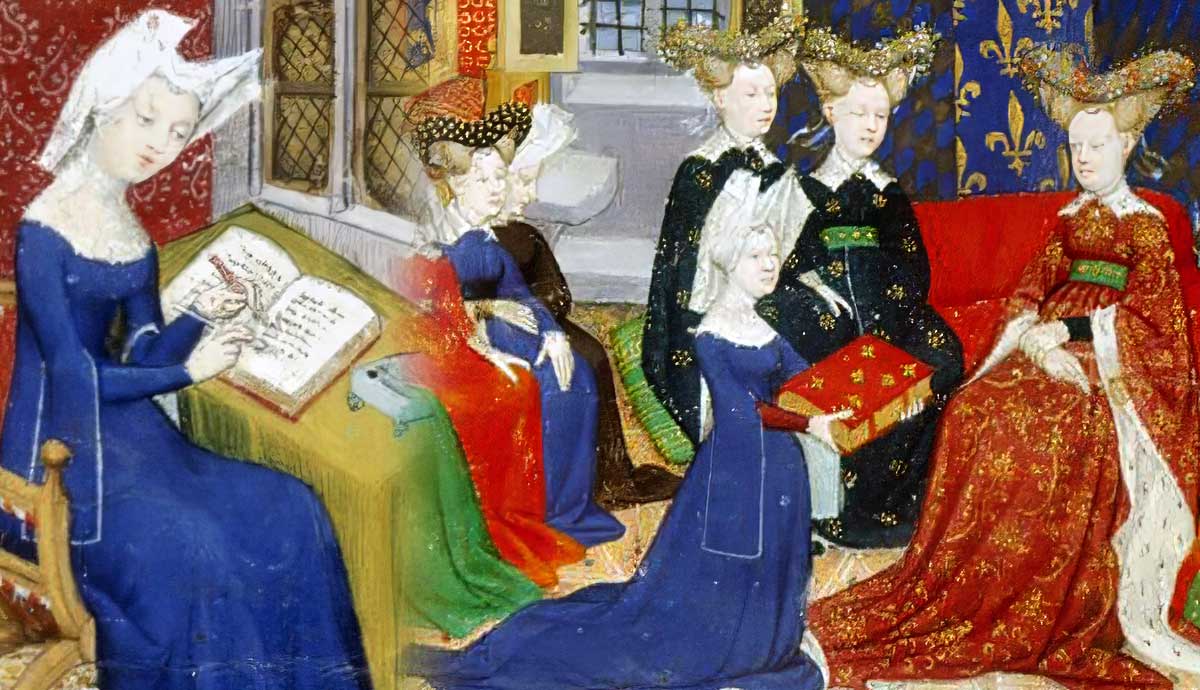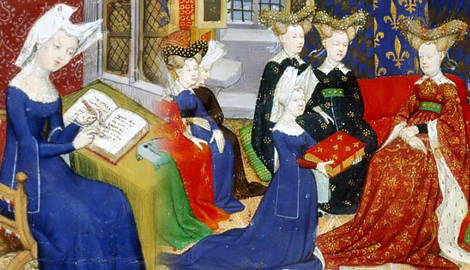
Born in Italy in 1364 but a resident of France for almost her entire life, Christine de Pizan was a remarkable woman living in challenging times – not just for herself and her family but also for France, the country she came to view as her home. After the deaths of all viable male heads of the family household, it fell to her to support her mother and children, which she accomplished through her literary talents. In doing so, she became France’s first professional female writer and secured her legacy as Europe’s first feminist (or proto-feminist) author. Here, we will explore her life and work in the medieval French royal court.
Early Life

Though she is considered one of France’s most famous authors, Christine de Pizan was, in fact, born in what was then the Republic of Venice in Italy (where her father, Thomas de Pizan, worked as a physician, counselor, and court astrologer) in 1364. Her surname is derived from her father’s family’s origins in Pizzano, a village to the southeast of Bologna.
Not long after her birth, however, Thomas de Pizan was appointed the King of France’s astrologer, so the family moved to Paris in 1368 when he took up his new post. Now ensconced in the French court, Christine de Pizan went on to marry Étienne du Castel, a notary and royal secretary, in 1379. Together, the couple had three children, one of whom accompanied Charles VI’s daughter, Marie of France, to the Dominican convent of Poissy in 1397, where they both took holy orders and became nuns.
Though she was certainly mixing in fairly exalted circles, Pizan’s life thus far may be considered a fairly typical one for a medieval woman of marriage and childbearing. However, when her husband succumbed to the plague in 1389 – just one year after the death of her father – it fell to her to financially support not only herself and her children but also her mother.
Forging a Career at the French Court

In pursuit of this aim and taking advantage of her pre-existing links with the French court, she resolved to earn her living with her pen and became a court writer. Initially, at least, this involved penning popular love ballads. In so doing, she curried favor with members of the court and secured patronage, which not only allowed her to support her family but also made her Europe’s first professional female writer.
Among her patrons were Louis I of Orléans (the King of France’s brother), Philip II the Bold of Burgundy, and Philip’s son, John the Fearless. Promulgating the idea that France (much like Rome in Virgil’s Aeneid) had been founded by descendants of the Trojans, she published L’Épistre de Othéa a Hector (Letter of Othea to Hector) in 1400, dedicating the work to Louis of Orléans. In L’Épistre de Othéa a Hector, the Trojan prince and heroic warrior Hector receives tutelage in statesmanship from the goddess of wisdom, Othéa.

This being the French court, however, ultimate power lay with the King and Queen. King Charles VI, however, was incapacitated at various points during his reign due to several mental breakdowns. This then created something of a power vacuum, which, in turn, led to political turmoil. As his reign progressed, he lost the ability to make decisions on his own authority and instead had to win the approval of a royal council.
During his absences from the court, Queen Isabeau was left in charge, often with the assistance of Blanche of Castile, who acted as regent of France and so helped stabilize power relations within the court. While France was very much a patriarchal society, selected women in the court wielded considerable power – a fact that was not lost on de Pizan.
Pizan’s Proto-Feminist Writings

Within the French court, Pizan was made aware of highly capable women who wielded considerable power. She understandably, therefore, took exception to other (male) writers who portrayed women as alternately inept and immoral. In 1402, she waded into the so-called “Querelle du Roman de la Rose” when she called into question the literary value of Guillaume de Lorris and Jean de Meun’s hugely popular Romance of the Rose: a prime example of courtly literature in which women are there merely to seduce or be seduced.
In 1399, however, she had already made her feelings known on Lorris and Meun’s Roman when she wrote her Epistre au dieu d’Amours (Letter of the God of Love). Here, she defends women from the criticisms frequently leveled against them and instead criticizes Le Roman de la Rose (among other texts) not only for its shallow and denigratory treatment of women but for its implicit encouragement of immorality.
Not long after the “Querelle du Roman de la Rose,” in 1405, she published Le Livre de la cité des dames (The Book of the City of Ladies) and Le Livre des trois vertus (The Book of Three Virtues, also known as The Treasure of the City of Ladies) – the books that secured her place as Europe’s first explicitly feminist author. Written in French vernacular prose, in The Book of the City of Ladies, she conjures an allegorical city populated by women of history and myth whose spiritual, intellectual, political, royal, and literary merits have allowed them to contribute towards society, thus offering a further riposte to Lorris and Meun’s Roman de la Rose. The Treasure of the City of Ladies, on the other hand, is an education manual for women inspired (quite literally, according to de Pizan) by the Three Virtues: Reason, Rectitude, and Justice.
France at War & Christine de Pizan’s Later Years

With the political situation worsening in France from around 1405, John I of Burgundy (also known as John the Fearless and one of Pizan’s patrons) precipitated a political crisis by ordering the assassination of Louis of Orléans in 1407. Though John of Burgundy left Paris once his role in the assassination became public knowledge, he was made regent of France in 1408 on account of his victory in the Battle of Othée that same year.
Having already written on the king’s role as a military leader in Livre du Corps de policie in 1407, Pizan went on to publish Livre des fais d’armes et de chevalerie, a manual on chivalry, in 1410. Here, she grappled with moral issues surrounding war, including Honoré Bonet’s just war theory, while also conforming with the accepted belief that God oversees warfare and ensures justice is served on the battlefield.
Though the manual was written in French (rather than Latin) to make it more accessible, Pizan draws on the opinions of classical writers on warfare, including Vegetius and Valerius Maximus. Ever a proponent for the French royal family, she argued that the right to wage war belonged solely to sovereign kings (and, just one year after the publication of her manual, the French royal court issued an edict that forbade nobles from raising armies). The royal treasury also paid her 200 livres for her manual.
Following the outbreak of civil war in 1407, however, Pizan’s thoughts turned to peace. In 1413, she published Livre de la Paix (The Book of Peace), in which she advised the dauphin on governing the country. Inspired by Dante, St. Benedict, and Cicero, she urged the dauphin to earn respect by exercising mercy and dispensing justice and exhorted him to press for peace. He died in 1415.

That same year, France suffered another devastating turn of events at the Battle of Agincourt. Their unexpected defeat by a much smaller troop of English soldiers led Pizan to publish Epistre de la prison de vie Humanine (Letter Concerning the Prison of Human Life) to offer consolation to those women who had lost loved ones at Agincourt. Here, she had abandoned her previous optimism that peace could be achieved on earth and instead turned her attention to the fate of the eternal soul. Pizan’s Epistre de la prison de vie Humanine was presented to Marie of Berry, whose husband was a captive of the English.
Pizan’s hopes for France, however, would rise again thanks to one woman’s victory over the English in the 1429 Siege of Orléans: Joan of Arc. Pizan was inspired to publish the poem Ditié de Jehanne d’Arc (The Tale of Joan of Arc) that same year, just a matter of days after the coronation of Charles VII. Here, Pizan is at her most patriotic, casting Joan of Arc as the means by which the new king was to fulfill the prophecies of Charlemagne. However, during the Siege of Compiègne, Joan was captured and subsequently executed by English and Burgundian forces in 1431.
Though it is not known for certain when Pizan died, it is believed that she did not live to know of Joan’s capture and execution. But Pizan, like Joan of Arc, left behind a powerful and inspiring legacy. “All women” should lay flowers “upon the tomb of Aphra Behn,” wrote Virginia Woolf in A Room of One’s Own, “for it was she who earned them the right to speak their minds.” Many and great though Behn’s accomplishments assuredly were, however, it was Christine de Pizan who was the first female professional writer in Europe.










